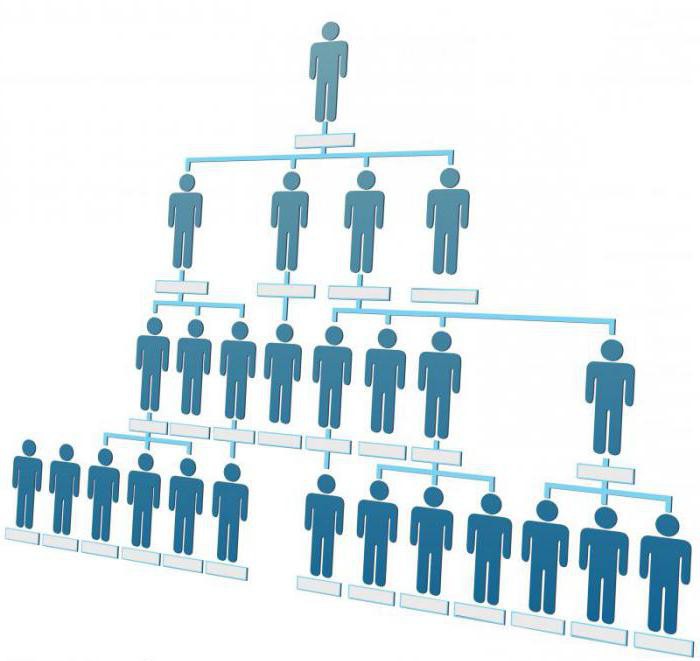There are two types of organizational structures recognized as ideal: functional and divisional. Both of them differ in certain features.
Functional organizational structure has such a management that, with the exception of the highest authority in the form of the management or board of the enterprise, structural units will be carried out on the basis of the functions assigned to them.
A divisional organizational structure will exist if the organization was built on the principle of an object, that is, the formation of units was carried out on a productive basis. In the first case, the main organizational structures can be called functional services, and in the second - divisions.

It is usually difficult to make a general assessment of these structures, since it is almost impossible to find organizational structures in their pure form in practice, the mixed type prevails. Add to this the fact that the disadvantages and advantages of both options matter only because of the corresponding situational components of the organizational context. However, the divisional organizational structure has properties that are worth considering.
Base component
This model is traditionally used to build the structure of the largest organizations that create production divisions within corporations, giving them some independence in carrying out operational activities. At the same time, the administration reserved the right to tight control on issues that are corporate-wide: these are strategies for further development, investments, innovative developments, and others.
The organizational structure scheme in this case assumes that the key figures here will be not managers, but managers who head the production departments. To structure an organization by department, one of three criteria is usually used:
- product specialization involves emphasis on manufactured products or services;
- consumer specialization implies a mandatory orientation on the consumer;
- Regional specialization takes into account the areas that are in service.
What does it give?
The divisional organizational structure is effective due to the fact that it provides the closest possible connection between production and the consumer, significantly accelerating the reaction of the former to changes inherent in the external environment. The results of expanding the boundaries of the operational and economic independence of the department are now considered as “profit centers”, therefore they are given freedom of action to increase the degree of efficiency of current activities.

Areas of use
The divisional organizational structure can be most actively applied in the following cases:
- in multidisciplinary enterprises;
- at enterprises located in different regions;
- at enterprises whose activities involve the implementation of complex innovative processes.
The divisional type of organizational structure suggests that the units forming it are united among themselves, as well as with the center through production, administrative and financial ties. This management structure is characterized by certain advantages and disadvantages.
Benefits
Among the pluses are the following:
- - directory relationships are formed on a linear basis;
- coordination tools in conjunction with technical support are used quite powerfully;
- market changes trigger an instant reaction;
- senior company executives are free from routine and operational decisions;
- responsibility is clearly delineated;
- the system is flexible and very adaptive;
- structural units are characterized by independence;
- network communication is simplified to the impossible;
- high motivation with full personnel autonomy.

Each advantage of the divisional organizational structure provides ample opportunities for its use.
disadvantages
Among the minuses are the following:
- leading cadres are in high demand;
- coordination is very complicated;
- due to the duplication of functions, costs increase markedly;
- a single policy cannot be implemented;
- the staff is fragmented;
- synergistic effect weakens.
Other options
Functional and divisional organizational structures received the antipode in the form of an organic type. The main direction of the organic model of organizational design is taken to achieve a high degree of adaptability of development within the limited use of procedures and rules, a low degree of independence with a high level of decentralization of power.
Organic types of organizational structures differ from all others in that they satisfy the need of entrepreneurs in a high degree of adaptability and flexibility to environmental market conditions that change very quickly. The essence of the organic structure is as follows: it completely rejects the idea that the organization will be effective in the case of a clear structure and when working is similar to a clearly debugged mechanism. This model is focused on the implementation of radical changes to ensure the required level of adaptability. The basis of such an organization is based on opportunities, not limitations, it finds new actions, and does not cling to old ones, preferring discussions to calm conversations, and encouraging contradictions and doubts, not taking all decisions coming from the leadership on faith.

It is worth saying that the organizational type chart of the organic type is not yet fully operational, as it is at the initial stage of its formation, and in its pure form individual organizations use it. However, elements of this approach to the managerial structure began to spread quite widely, especially in companies aimed at quickly adapting to a changing environment. The organic model has become the base, therefore, types of organizational structures are built on it, such as team, matrix, design.
At the origins of the divisional structure
To understand the essence of this approach, you should consider how it all began. The divisional organizational structure was created by employees of General Motors and Dupont Alfred P. Sloan and Pierre S. Dupont. They developed a structure that was supposed to operate on the basis of semi-autonomous production departments, which were formed depending on the brand, type of product or on the basis of geographical location.
The management of the production activities of each department was carried out separately. The tasks of the General Directorate were the distribution of resources between the departments and the development of strategic plans. Despite the fact that the divisional organizational structure originated in the twenties of the last century, they began to use it only in the seventies. Big companies began to rebuild their management structures due to the complication of technological activities, diversification of production and in the face of changes in the market environment. It was then that production departments began to appear. They gained independence in the framework of operational activities.However, the rights of the administration extended to control on the issues of the strategy for subsequent development, investment, research and development. The organizational chart has begun to change in favor of combining centralized coordination with decentralized management. This gave a certain effect.
Structural Properties
The divisional organizational structure is effective due to the fact that each branch has become an independent business unit in relation to the central administration. The department manager has full authority, as well as all responsibility for the effectiveness of the unit. The company includes a couple of branches. Usually, its head is a collective body, that is, a board of directors, which includes department heads. The responsibility of the general management of the company and its central office includes the appointment of managers, the allocation of resources, the implementation of limited control functions, and the development of strategic plans. In addition to all this, it is they who are engaged in the search for sources of financing, as well as in the preparation of money plans for the branches.

Types
The divisional organizational structure of a company at the moment can be one of three types. Let's consider them in more detail.
Productive
It consists of a pair of autonomous business units, that is, branches, the purpose of each of which is its own sector of the food market. In relation to the entire organization, each of them acts as a profit center.
The developed form assumes that each department will perform functions corresponding to the linear staff structure, that is, they have sales, marketing, design and other departments. The reference model assumes that the number of branches corresponds to the number of sectors of the food market that this organization serves.

The linear divisional organizational structure is aimed at gaining market positions and maximizing profits. General Motors is the first company to start working on this principle. She created 5 independent branches: Pontiac, Oldsmobile, Chevrolet, Buick and Cadillac. The disadvantage of this structure is often called an increase in costs, which is associated with duplication of similar types of work for different types of products.
Customer focus
This is a typical development of a productive structure, which is used to serve certain consumer groups that are more important for the organization, while the mandatory and painstaking consideration of all the subtleties of customer requests is a must. The division of the organizational structure according to this principle is found in Russia. For example, large book publishers have special units that produce literature for adults, adolescents, and textbooks for higher and secondary schools. Each of these divisions has a reference point for its own client audience, so their actions are similar to the work of independent companies.
Regional
The regional organizational structure of the company is almost always used by those organizations that in different regions have their own branches. By means of the regional structure, it is simplified to solve various difficulties that are associated with local legislation, features of the organization’s culture, specific attitudes, needs and demands of consumers.
This type is most widely used by the trading and marketing divisions of large companies that operate in vast geographical areas. They can be divided into smaller blocks. Packaging companies or drug companies may form subsidiaries with multifunctional structures in different regions.

Quite often, this type is used by non-profit organizations, for example, political parties, trade unions, creative unions and others.
Which structure to choose?
The divisional type of organizational structure is selected in the case when it is most suitable for the implementation of strategic plans of the organization. The advantages of this solution are as follows:
- external conditions cause an immediate operational response from the company;
- in production structures there is a rapprochement of current and strategic tasks;
- responsibility and decision-making are at the same level;
- regional managers receive conditions for effective growth;
- within one division, we can talk about maximum coordination.
This type of organizational structure has well-defined shortcomings:
- struggle within the organization for qualified managers and resources;
- an increase in the cost of maintaining the management apparatus due to duplication of the same types of work;
- an increase in the degree of hierarchy requires coordination at all levels, due to which the terms of approvals grow and decision-making processes become slower.








